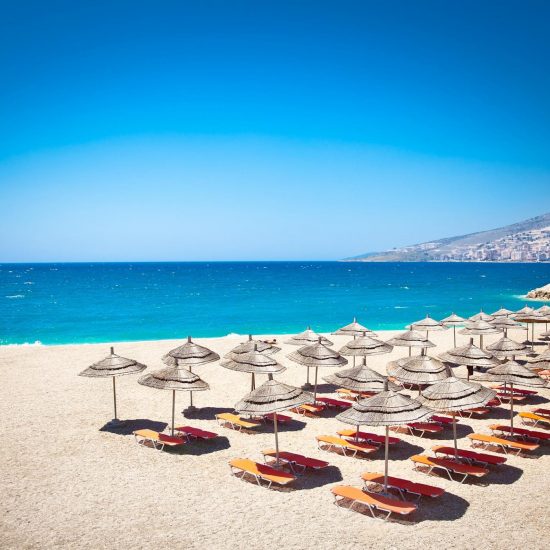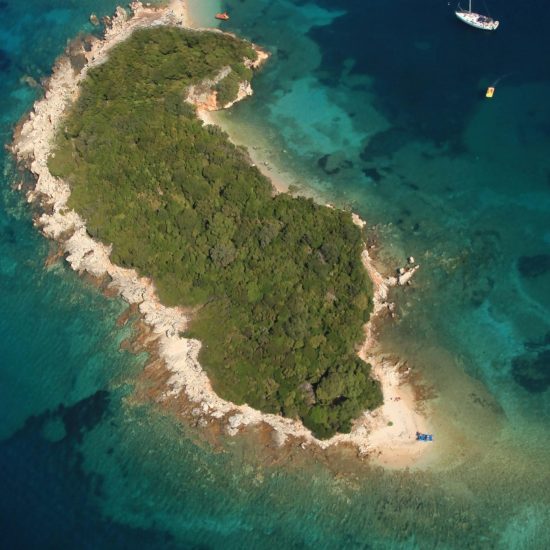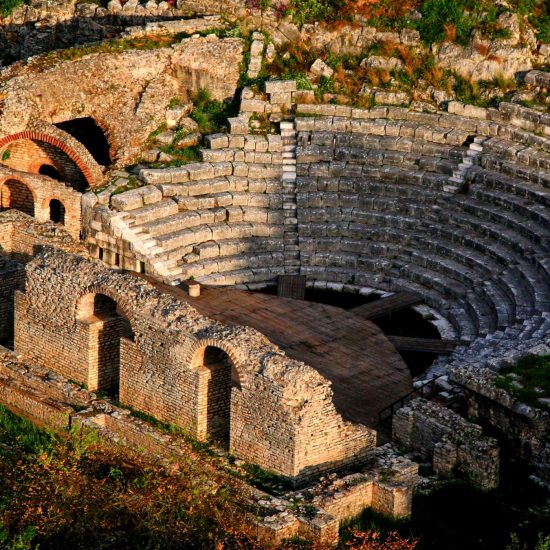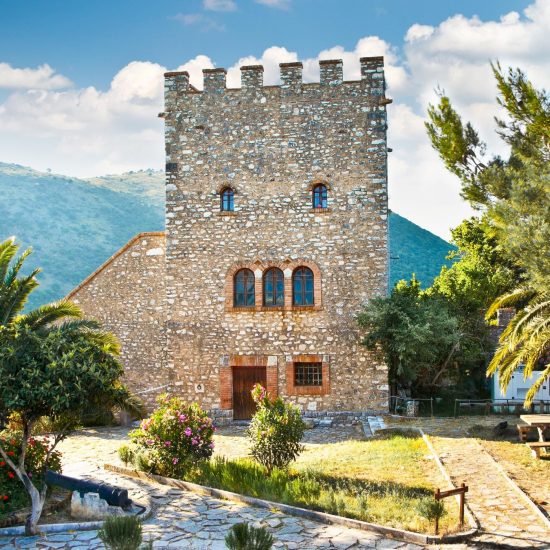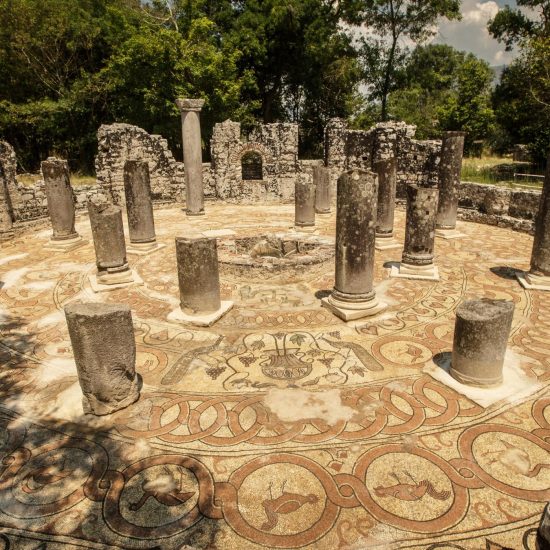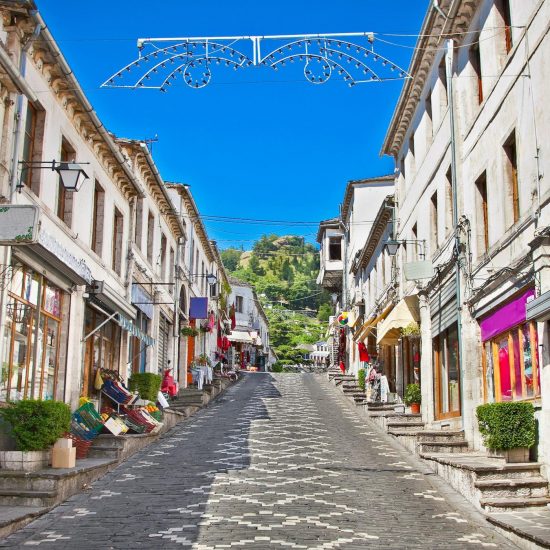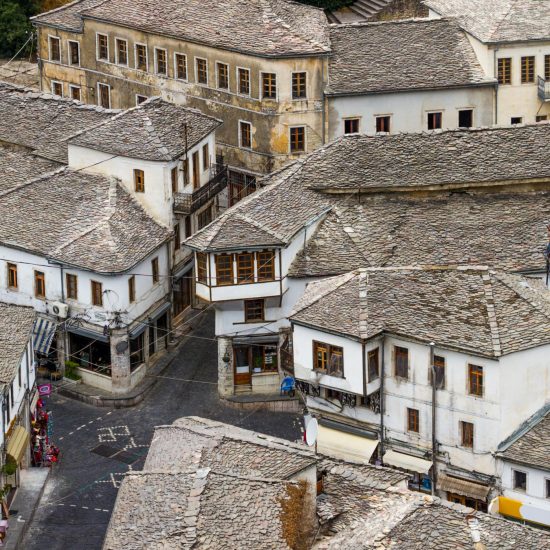Saranda - Ksamil
Saranda, the south Albanian seaport is located on a natural shelf facing the island of Corfu. There are daily ships that connect Saranda with this Greek island. Saranda’s name originates from “the Forty Saints,” an old Christian monastery (Saranda means “forty” in Greek). The ruins of the monastery lay in Qafa e Gjashtës, near the city entrance. Prior to Byzantine rule, Saranda was called by its ancient Greek name, “Onchesmos,” after the father of the Trojan prince Aeneas, who was born at Mount Ida by the Greek goddess, Aphrodite.
The city lies at the southern tip of Albania’s Ionian coastline and has a very pleasant avenue, full of palm trees and pebbled beaches. In the center of the city stand the ruins of the ancient city of Onhezmi, destroyed in the 5th century A.D. by invading barbarians. In 2002, a synagogue was uncovered in the same area. Just 2 km south of Saranda, on the top of a massive hill, is the Castle of Lëkurs. The castle was built by Sultan Suleiman during his military campaign against Corfu. Today a restaurant sits in the fortress, offering a rich cuisine and breathtaking views of the deep blue Ionian Sea.
Heading south, the coastline changes its appearance. Four small islands emerge in the Ksamil area, covered by Mediterranean vegetation and surrounded by wonderful marine flora and fauna. A salt lake, a lagoon of tectonic origin, lies inland near Butrint. In antiquity it was known by the name Pelodes and it connects to the sea through the channel of Vivar, 3.6 km in length. Tourists can find a large number of sea birds nesting there.
Butrinti
South of Butrint Lake, 18 km from Saranda, sits the ancient city of Butrint, the most important archaeological site in Albania, and a UNESCO World Heritage Site. The name of Butrint has been well known since the 7th century B.C. as the most important city of Epirus. According to Dionysius of Halicarnassus, the building of Butrint was linked to the presence of the Trojan prince Aeneas during his travel to the temple of Dodona. He paid tribute to the oracle of Dodona by sacrificing a bull (Buthros in Greek) in the place where the city of Butrint began to rise. The Roman poet Virgil also mentions the visit of Aeneas to Butrint in his poem, “The Aeneid”.
There are many sights to see within Butrint. The most interesting ones are the Temple of Asclepius (the god of good health; 2nd century BC), a 1,500 seat theater from the 3rd century B.C. (which now hosts the International Theatre Festival every September), the Baptismal (a paleo-Christian monument), as well as the nymphet, the baths, the stoa (colonnade), the Lake Gate, the Lion Gate, the Venetian fortress of Ali Pasha, and many others. Besides its historical value, Butrint is renowned for its marvelous ecological system. The ruins and the buildings of the city stand amidst an amazing subtropical jungle, with plenty of laurel and other high trees.
Gjirokastra
As you depart from Saranda, the national highway will lead you to the unique city of Gjirokastra, only 56 km away. On the way, just 10 km from Saranda, travelers will find Finiqi, the capital of the Kingdom of Epirus (and named Foinike at the time), which was founded in the 3rd and 2nd centuries B.C. in the territory of Kaonia.
The historian Polybus called it, “the most rich and fortified city of Epirus.” Southwest of Finiqi in the hilltop village of Mesopotam is the Church of Shën Kolli, built during the Byzantine period. One of the most pleasant surprises along this journey is Syri i Kaltër (the Blue Eye), a powerful natural spring that has created a small lake of crystal clear water that looks like a giant human eye. The specialty of the nearby restaurant is the lake trout. Past Qafa e Muzinës you’ll meet the national Gjirokastër-Kakavijë highway. As you leave the village of Dropulli on your left, the museum city of Gjirokastra unfolds in front of you, built on the eastern slope of Mali i Gjerë. Due to its architecture, Gjirokastra is also known as the “City of Stone” or “City of a Thousand Steps.” It is an ancient city with early inhabitants, in which was later constructed a fortress that served as the center of the city. What most attracts visitors to Gjirokastra are the traditional tall houses made of stone, which resemble small fortresses, together forming a unique architectural complex. Due to its architectural uniqueness, Gjirokastra is a UNESCO World Heritage Site. The main structure is the city fortress, named the Fortress of Argjiro – the renowned story of the famous princess Argjiro gave rise to the name “Argjirokastro,” given to the city in 1336.
The Weapons Museum, located inside of the fortress, displays weapons from the Paleolithic period up until the Second World War. During your stay in Gjirokastra you also can visit the Ethnographic Museum. Gjirokastra is famous for its food specialties such as shapkat, laropit, byrek (different kinds of pies), and several dairy products known throughout Albania. Some of the more interesting buildings and places you might visit are the Theater of Sofratika, the ancient city of Antigone, the Tekke of Melan, and the village of Sotira.
The Theatre of Sofratika, part of the Roman city Adrianopoli, developed from the 2nd century A.D., held 4,000 spectators in twenty-seven tiers. Antigone is an ancient city from the 2nd century B.C. and is currently an archaeological park located in the Lunxhëri district, east of Gjirokastra and close to the village of Saraqinisht. It is thought that the city was founded by King Pyrrhus of Epirus, who named the city after his wife Antigone. The city was 35 hectares in size; its ruins are located on a hill at 600 m above sea level. Tourists can visit the remains and fragments of the surrounding wall, the agora, and the stoa of the city, which are 59 m long and 9 m wide. It is worth mentioning that in the area, archaeologists discovered a seven-inch bronze statue representing Poseidon, God of the Sea, and the Sphinx of Antigone.
Both objects are displayed in the National History Museum in Tirana. The Tekke of Melan can be found only 4 km south of the small city of Libohova. This religious building of the Bektashi sect is open to everyone and guests are not only welcome but also treated with special hospitality. The village of Sotira is located in the region of Dropulli, populated by a Greek minority. It is a mountain village of a rare beauty with little stone houses surrounded by the fir forest of Sotira and many water springs. The region of Dropulli, is known all over Albania for its fine women’s’ folk costumes and their elegant dances.
Saranda, the south Albanian seaport is located on a natural shelf facing the island of Corfu. There are daily ships that connect Saranda with this Greek island. Saranda’s name originates from “the Forty Saints,” an old Christian monastery (Saranda means “forty” in Greek). The ruins of the monastery lay in Qafa e Gjashtës, near the city entrance. Prior to Byzantine rule, Saranda was called by its ancient Greek name, “Onchesmos,” after the father of the Trojan prince Aeneas, who was born at Mount Ida by the Greek goddess, Aphrodite.
The city lies at the southern tip of Albania’s Ionian coastline and has a very pleasant avenue, full of palm trees and pebbled beaches. In the center of the city stand the ruins of the ancient city of Onhezmi, destroyed in the 5th century A.D. by invading barbarians. In 2002, a synagogue was uncovered in the same area. Just 2 km south of Saranda, on the top of a massive hill, is the Castle of Lëkurs. The castle was built by Sultan Suleiman during his military campaign against Corfu. Today a restaurant sits in the fortress, offering a rich cuisine and breathtaking views of the deep blue Ionian Sea.
Heading south, the coastline changes its appearance. Four small islands emerge in the Ksamil area, covered by Mediterranean vegetation and surrounded by wonderful marine flora and fauna. A salt lake, a lagoon of tectonic origin, lies inland near Butrint. In antiquity it was known by the name Pelodes and it connects to the sea through the channel of Vivar, 3.6 km in length. Tourists can find a large number of sea birds nesting there.
Butrinti
South of Butrint Lake, 18 km from Saranda, sits the ancient city of Butrint, the most important archaeological site in Albania, and a UNESCO World Heritage Site. The name of Butrint has been well known since the 7th century B.C. as the most important city of Epirus. According to Dionysius of Halicarnassus, the building of Butrint was linked to the presence of the Trojan prince Aeneas during his travel to the temple of Dodona. He paid tribute to the oracle of Dodona by sacrificing a bull (Buthros in Greek) in the place where the city of Butrint began to rise. The Roman poet Virgil also mentions the visit of Aeneas to Butrint in his poem, “The Aeneid”.
There are many sights to see within Butrint. The most interesting ones are the Temple of Asclepius (the god of good health; 2nd century BC), a 1,500 seat theater from the 3rd century B.C. (which now hosts the International Theatre Festival every September), the Baptismal (a paleo-Christian monument), as well as the nymphet, the baths, the stoa (colonnade), the Lake Gate, the Lion Gate, the Venetian fortress of Ali Pasha, and many others. Besides its historical value, Butrint is renowned for its marvelous ecological system. The ruins and the buildings of the city stand amidst an amazing subtropical jungle, with plenty of laurel and other high trees.
Gjirokastra
As you depart from Saranda, the national highway will lead you to the unique city of Gjirokastra, only 56 km away. On the way, just 10 km from Saranda, travelers will find Finiqi, the capital of the Kingdom of Epirus (and named Foinike at the time), which was founded in the 3rd and 2nd centuries B.C. in the territory of Kaonia.
The historian Polybus called it, “the most rich and fortified city of Epirus.” Southwest of Finiqi in the hilltop village of Mesopotam is the Church of Shën Kolli, built during the Byzantine period. One of the most pleasant surprises along this journey is Syri i Kaltër (the Blue Eye), a powerful natural spring that has created a small lake of crystal clear water that looks like a giant human eye. The specialty of the nearby restaurant is the lake trout. Past Qafa e Muzinës you’ll meet the national Gjirokastër-Kakavijë highway. As you leave the village of Dropulli on your left, the museum city of Gjirokastra unfolds in front of you, built on the eastern slope of Mali i Gjerë. Due to its architecture, Gjirokastra is also known as the “City of Stone” or “City of a Thousand Steps.” It is an ancient city with early inhabitants, in which was later constructed a fortress that served as the center of the city. What most attracts visitors to Gjirokastra are the traditional tall houses made of stone, which resemble small fortresses, together forming a unique architectural complex. Due to its architectural uniqueness, Gjirokastra is a UNESCO World Heritage Site. The main structure is the city fortress, named the Fortress of Argjiro – the renowned story of the famous princess Argjiro gave rise to the name “Argjirokastro,” given to the city in 1336.
The Weapons Museum, located inside of the fortress, displays weapons from the Paleolithic period up until the Second World War. During your stay in Gjirokastra you also can visit the Ethnographic Museum. Gjirokastra is famous for its food specialties such as shapkat, laropit, byrek (different kinds of pies), and several dairy products known throughout Albania. Some of the more interesting buildings and places you might visit are the Theater of Sofratika, the ancient city of Antigone, the Tekke of Melan, and the village of Sotira.
The Theatre of Sofratika, part of the Roman city Adrianopoli, developed from the 2nd century A.D., held 4,000 spectators in twenty-seven tiers. Antigone is an ancient city from the 2nd century B.C. and is currently an archaeological park located in the Lunxhëri district, east of Gjirokastra and close to the village of Saraqinisht. It is thought that the city was founded by King Pyrrhus of Epirus, who named the city after his wife Antigone. The city was 35 hectares in size; its ruins are located on a hill at 600 m above sea level. Tourists can visit the remains and fragments of the surrounding wall, the agora, and the stoa of the city, which are 59 m long and 9 m wide. It is worth mentioning that in the area, archaeologists discovered a seven-inch bronze statue representing Poseidon, God of the Sea, and the Sphinx of Antigone.
Both objects are displayed in the National History Museum in Tirana. The Tekke of Melan can be found only 4 km south of the small city of Libohova. This religious building of the Bektashi sect is open to everyone and guests are not only welcome but also treated with special hospitality. The village of Sotira is located in the region of Dropulli, populated by a Greek minority. It is a mountain village of a rare beauty with little stone houses surrounded by the fir forest of Sotira and many water springs. The region of Dropulli, is known all over Albania for its fine women’s’ folk costumes and their elegant dances.



